Investigation of the Ampacity of a Prefabricated Straight-Through Joint of High Voltage Cable
Abstract
:1. Introduction
2. Numeric Thermal Field Analysis of a Prefabricated Straight-Through Cable Joint of 110 kV XLPE Cable
2.1. Cable Joint Geometric Model
- (1)
- The cable has a stranded conductor and the cable joint is treated as a cylinder.
- (2)
- The copper protective shell is considered to be a cylindrical structure ignoring the influence of its top ground stud.
- (3)
- The equivalent radius is used to describe the corrugated aluminum sheath of the cable.
- (4)
- Small geometries, such as the earthling rod, the stress relief cone, and the shrinking belt around the copper shell, are neglected.
2.2. Boundary Conditions in Modelling
- One end of the cable joint’s conductor is set as the reference potential, and another end is loaded with different currents to simulate various operation conditions (as the load current is 50 Hz AC, the dielectric loss in the joint insulation is negligible).
- The aluminium sheath is single-end grounded, so the circulation loss on the aluminium sheath is negligible.
- At the surface of joint, the temperature is a function of time and position (the first type of boundary condition).
- At the surface of joint, the heat flux normal to the surface is a function of time and position (the second type of boundary condition).
- At the surface of joint, contact with another medium can exist (the third type of boundary condition).
2.3. Setting the Approximated Adiabatic Plane
2.4. Numerical Results and Analysis
- As shown in Figure 5, there is a temperature gradient along the axial direction of the cable joint’s conductor. The highest conductor temperature is at the center of the connecting tube, and reaches 91.1 °C, and the conductor temperature decreases to 69.7 °C along the axial direction away from the connecting tube. The cable joint’s structural characteristics and material thermo-physical properties cause the equivalent radial thermal resistance of the joint to be higher than that of the cable body. Therefore, the radial temperature difference inside the joint is higher than that inside the cable body under the same radial heat flow. This leads to an axial heat conduction between the joint conductor and the cable body conductor. As distance away from the connection tube increases, the effect of axial heat transfer gradually decreases, and the conductor temperature tends to be stable. From the above study, we found that the difference in surface temperatures between the cable joint and cable body is not significant (41.2 °C and 39.1 °C, respectively).
- As is the case with the cable body, the ampacity of the cable joint is subject to the capability of the insulation to withstand long-term high temperature. Figure 6 presents the sampling result of the system shown in Figure 4. It can be seen that the insulation section of the joint adjacent to the conductor reaches 89.8 °C, which is higher than the highest temperature of the joint’s main insulation (81.7 °C). As a result, the temperature at the insulation section of the joint adjacent to the conductor becomes the critical factor limiting the ampacity of the cable joint. This section is the critical spot.
- With the load current of 1230 A, the steady-state temperature of the conductor of the cable body is only 69.7 °C. In contrast, the highest steady-state temperature within the XLPE insulation of the joint is 89.8 °C. This temperature is almost equal to the long-term tolerance temperature (90 °C) of XLPE insulation. Therefore, the insulation of the cable joint is the critical component in determining the ampacity of a cable system.
- As the distance away from the connecting tube increases, the cable joint’s surface temperature exhibits a slow increasing trend (from 41.2 °C to 43.5 °C) and the cable body’s surface temperature decreases to a constant value (from 43.5 °C to 39.1 °C). Thus, the highest surface temperature of the joint occurs at the end of its copper shell.
- The modelling results reveal that the radial temperature difference inside the cable joint decreases with increasing distance away from the connecting tube. Figure 6 shows the radial thermal field distribution at the connecting tube. The temperature difference between the inner and outer diameter of each component of the connecting tube are provided in Table 2. The largest decrease in temperature in the radial direction is in the joint’s main insulation (27.9 °C) due to its thickness being the largest. Moreover, the temperature gradient in the air layer (air layer 2 in Table 2) between the copper screen tube and the stress control tube reaches 9.7 °C. This is due to the low thermal conductivity of air.
3. Experimental Study of a Prefabricated Straight-Through Cable Joint of 110 kV XLPE Cable
3.1. Experimental Setup
3.2. Results and Discussion
- When applying different load currents to the joint, the maximum temperature at the steady state obtained from modelling was lower than that obtained from experiments. The discrepancies (e.g., modelling error) increased with increasing the applied load current. This might be due to the use of a connection tube in the joint, which introduces a contact resistance that may elevate the heat generation of the cable joint. The value of this contact resistance is affected by many factors and it is difficult to determine by modelling. The absence of contact resistance in the FEA modelling results in reduced heat generation of the joint; and in turn, the modelling generated lower temperature estimations compared to the experiments. With the increase of the load current, the inner temperature of the joint increases and leads to the increase of the contact resistance. This results in an increase in modelling error.
- Under different load currents, the largest modelling error of the steady state conductor temperature is in the copper shell port on the longer half of the joint. Due to the imperfection of the installation process, the aluminum sheath and the copper shell may not tightly overlap in the cable joint and a void may exist between them. The influence of the void was not considered in the modelling. On the other hand, the epoxy mud used to seal the end of the copper shell in the experiments was manually applied. As such, the real shape of the mud cannot be exactly described in modelling.
- The absolute error in the FEA modelling of the steady-state conductor temperature was less than 7% with reference to the experimental results. Thus, the model results are sufficiently accurate to be practically applied.
4. Ampacity Calculation of the Cable Joint
5. Conclusions
- This paper developed an electric-thermal coupling model for a prefabricated straight-through joint of a 110 kV cable system. The model was successfully applied to obtain the joint’s steady-state thermal distribution and to evaluate the joint’s ampacity.
- Based on the joint’s steady-state thermal distribution, as obtained by this model, it was pointed out that the XLPE insulation section of the joint adjacent to the conductor became the critical spot limiting the ampacity of the joint.
- Based on the algorithm presented in Section 4, it was found that the ampacity of a cable joint is much lower than the ampacity of its cable body.
- Comprehensive experiments on a real cable system with a prefabricated straight-through joint under different loading conditions were conducted. The experimental results verified that the model developed in this paper can be used for determining the ampacity of prefabricated straight-through joints of high voltage cable.
Acknowledgments
Author Contributions
Conflicts of Interest
References
- Li, H.J.; Tan, K.C.; Su, Q. Assessment of underground cable ratings based on distributed temperature sensing. IEEE Trans. Power Deliv. 2006, 21, 1763–1769. [Google Scholar] [CrossRef]
- Huang, R.; Pilgrim, J.A.; Lewin, P.L.; Payne, D. Dynamic cable ratings for smarter grids. In Proceedings of the 4th IEEE PES Innovative Smart Grid Technologies Europe, Copenhagen, Denmark, 6–9 October 2013; pp. 1–5. [Google Scholar] [CrossRef]
- Marc, D.A.; Francisco, L. Adaptive soil model for real-time thermal rating of underground power cables. IET Sci. Meas. Technol. 2014, 9, 654–660. [Google Scholar] [CrossRef]
- Li, Y.; Wouters, P.A.A.F.; Wagenaars, P.; Wielen, P.C.J.M.; Steennis, E.F. Temperature dependent signal propagation velocity: Possible indicator for MV cable dynamic rating. IEEE Trans. Dielectr. Electr. Insul. 2015, 22, 665–672. [Google Scholar] [CrossRef]
- Sujit, P.; Francisco, L.; Matthew, T. Calculation of cable thermal rating considering non-isothermal earth surface. IET Gener. Transm. Distrib. 2014, 8, 1354–1361. [Google Scholar] [CrossRef]
- Neher, J.H.; McGrath, M.H. The calculation of the temperature rise and load capability of cable systems. AIEE Trans. 1957, 76, 752–772. [Google Scholar] [CrossRef]
- Anders, G.J. Rating of Electrical Power Cable, 1st ed.; IEEE Press: New York, NY, USA, 1997. [Google Scholar]
- Anders, G.J. Rating of Electric Power Cables in Unfavourable Thermal Environment, 1st ed.; IEEE Press: Piscataway, NJ, USA, 2005. [Google Scholar]
- International Electrotechnical Commission. Calculation of the Current Rating of Electric Cables; IEC 60287; IEC Press: Geneva, Switzerland, 2006. [Google Scholar]
- Insulated Conductors Committee of the IEEE Power Engineering Society. IEEE GUIDE for Soil Thermal Resistivity Measurements; IEEE Std 442, reaffirmed 2003; IEEE: Piscataway, NJ, USA, 1981. [Google Scholar]
- Frank, D.W.; Jos, V.R.; George, A.; Bruno, B.; Rusty, B.; James, P.; Marcio, C.; Georg, H. A Guide for Rating Calculations of Insulated Cables; Cigré TB # 640; Cigré: Paris, France, 2015. [Google Scholar]
- International Council on Large Electricsystems. Cable Rating Verification; Cigré WG B1.56; Cigré: Paris, France, 2016. [Google Scholar]
- Benato, R.; Colla, L.; Dambone Sessa, S.; Marelli, M. Review of high current rating insulated cable solutions. Electr. Power Syst. Res. 2016, 133, 36–41. [Google Scholar] [CrossRef]
- Eric, D.; Laurent, M.; Udo, F.; Vince, B.; Christian, R.; Jose, M.M.; Asakiyo, U.; Graeme, B.; Mike, S. Large Cross-Sections and Composite Screens Design; Cigré Technical Brochure 272 by WG B1.03; Cigré: Paris, France, 2005. [Google Scholar]
- Benato, R.; Paolucci, A. Multiconductor cell analysis of skin effect in Milliken type cables. Electr. Power Syst. Res. 2012, 90, 99–106. [Google Scholar] [CrossRef]
- Villacci, D.; Vaccaro, A. Transient tolerance analysis of power cables thermal dynamic by interval mathematic. Electr. Power Syst. Res. 2007, 77, 308–314. [Google Scholar] [CrossRef]
- Luoni, G.; Morello, A.S.; Crockett, A.E. Continuous current rating for external and surface cooled cable systems. IEE Proc. C 1981, 128, 129–139. [Google Scholar] [CrossRef]
- Belli, S.; Perego, G.; Bareggi, A.; Caimi, L.; Donazzi, F.; Zaccone, E. P-Laser: Breakthrough in power cable systems. In Proceedings of the 2010 IEEE International Symposium Electrical Insulation(ISEI), San Diego, CA, USA, 6–9 June 2010. [Google Scholar] [CrossRef]
- Yang, F.; Cheng, P.; Luo, H.; Yang, Y.; Liu, H.; Kang, K. 3-D thermal analysis and contact resistance evaluation of power cable joint. Appl. Therm. Eng. 2015, 93, 1183–1192. [Google Scholar] [CrossRef]
- Pilgrim, J.A.; Swaffield, D.J.; Lewin, P.L.; Payne, D. An investigation of thermal ratings for high voltage cable joints through the use of 2D and 3D Finite Element Analysis. In Proceedings of the 2008 IEEE International Symposium on Electrical Insulation, Vancouver, BC, Canada, 9–12 June 2008; pp. 534–546. [Google Scholar] [CrossRef]
- Pilgrim, J.A.; Swaffield, D.J.; Lewin, P.L.; Payne, D. Assessment of the impact of joint bays on the ampacity of high-voltage cable circuits. IEEE Trans. Power Deliv. 2009, 24, 1029–1036. [Google Scholar] [CrossRef]
- Nakamura, S.; Morooka, S.; Kawaski, K. Conductor temperature monitoring system in underground power transmission XLPE cable joints. IEEE Trans. Power Deliv. 1992, 7, 1688–1697. [Google Scholar] [CrossRef]
- Abdel Aziz, M.M.; Riege, H. A new method for cable joints thermal analysis. IEEE Trans. Power Appar. Syst. 1980, 99, 2386–2392. [Google Scholar] [CrossRef]
- Chang, H.; Tan, T.; Ruan, J.; Gao, Y.; Liu, K. Research on temperature retrieval and fault diagnosis of the cable joint. In Proceedings of the 39th Annual Conference of the IEEE Industrial Electronics Society (IECON2013), Vienna, Austria, 10–13 November 2013; pp. 7388–7393. [Google Scholar] [CrossRef]
- Ruan, J.; Liu, C.; Huang, D.; Zhan, Q.; Tang, L. Hot spot temperature inversion for the single-core power cable joint. Appl. Therm. Eng. 2016, 104, 146–152. [Google Scholar] [CrossRef]
- Hwang, C.C.; Chang, J.J.; Chen, H.Y. Calculation of ampacities for cables in trays using finite elements. Electr. Power Syst. Res. 1999, 54, 75–81. [Google Scholar] [CrossRef]
- Lin, S.; Hu, W. Theoretical research on temperature field of power cable joint with FEM. In Proceedings of the International Conference on System Science and Engineering (ICSSE), Dalian, China, 30 June–2 July 2012; pp. 564–567. [Google Scholar] [CrossRef]
- Fu, J.; Cheng, P.; Chen, W.; Yang, Q.; Hu, X.; Wang, Q.; Yang, F. Investigation of the effects of insulation defects on the 3-D electromagnetic-thermal coupling fields of power cable joint. In Proceedings of the 2016 IEEE 11th Conference on Industrial Electronics and Applications (ICIEA), Hefei, China, 5–7 June 2016; pp. 1436–1439. [Google Scholar] [CrossRef]
- Yang, F.; Liu, K.; Cheng, P.; Wang, S.; Wang, X.; Gao, B.; Fan, Y.; Xia, R.; Ullah, I. The coupling fields characteristics of cable joints and application in the evaluation of crimping process defects. Energies 2016, 9, 932. [Google Scholar] [CrossRef]
- Illias, H.A.; Lee, Z.H.; Bakar, A.H.A.; Mokhlis, H.; Chen, G.; Lewin, P.L. Electric field distribution in 132 kV one piece premolded cable joint structures. In Proceedings of the IEEE International Conference of Condition Monitoring and Diagnosis, Bail, Indonesia, 23–27 September 2012; pp. 643–646. [Google Scholar] [CrossRef]
- Rachek, M.; Larbi, S.N. Magnetic eddy-current and thermal coupled models for the finite-element behaviour analysis of underground power cables. IEEE Trans. Magn. 2008, 4, 4739–4746. [Google Scholar] [CrossRef]
- Baehr, H.D.; Stephan, K. Heat conduction and mass diffusion. In Heat and Mass Transfer, 2nd ed.; Springer: Berlin, Germany, 2006; pp. 111–114. [Google Scholar]
- Liu, G.; Lei, M.; Ruan, B.; Zhou, F.; Li, Y.; Liu, Y. Model research of real-time calculation for single-core cable temperature considering axial heat transfer. High Volt. Eng. 2012, 38, 1877–1883. [Google Scholar] [CrossRef]
- Liu, G.; Lei, C. Experimental analysis on increasing temporary ampacity of single-core cable. High Volt. Eng. 2011, 37, 1288–1293. [Google Scholar] [CrossRef]
- Lei, C.; Liu, G.; Ruan, B.; Liu, Y. Experimental research of dynamic capacity based on conductor temperature-rise characteristic of HV single-core cable. High Volt. Eng. 2012, 38, 1397–1402. [Google Scholar] [CrossRef]
- Aras, F.; Oysu, C.; Yilmaz, G. An assessment of the methods for calculating ampacity of underground power cables. Electr. Power Compon. Syst. 2005, 33, 1385–1402. [Google Scholar] [CrossRef]
- Swaffield, D.J.; Lewin, P.L.; Sutton, S.J. Methods for rating directly buried high voltage cable circuits. IET Gener. Transm. Distrib. 2007, 2, 393–401. [Google Scholar] [CrossRef]


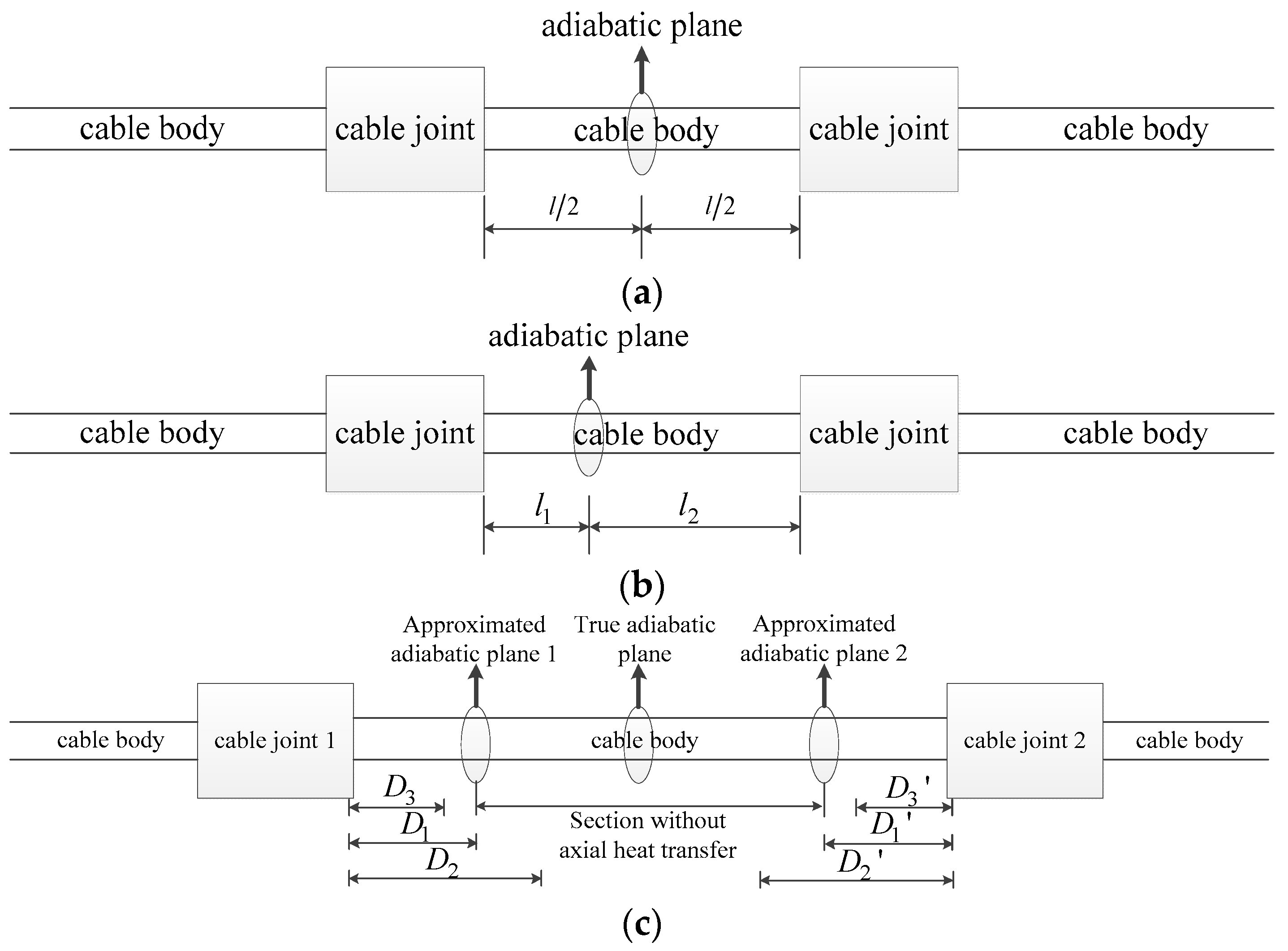
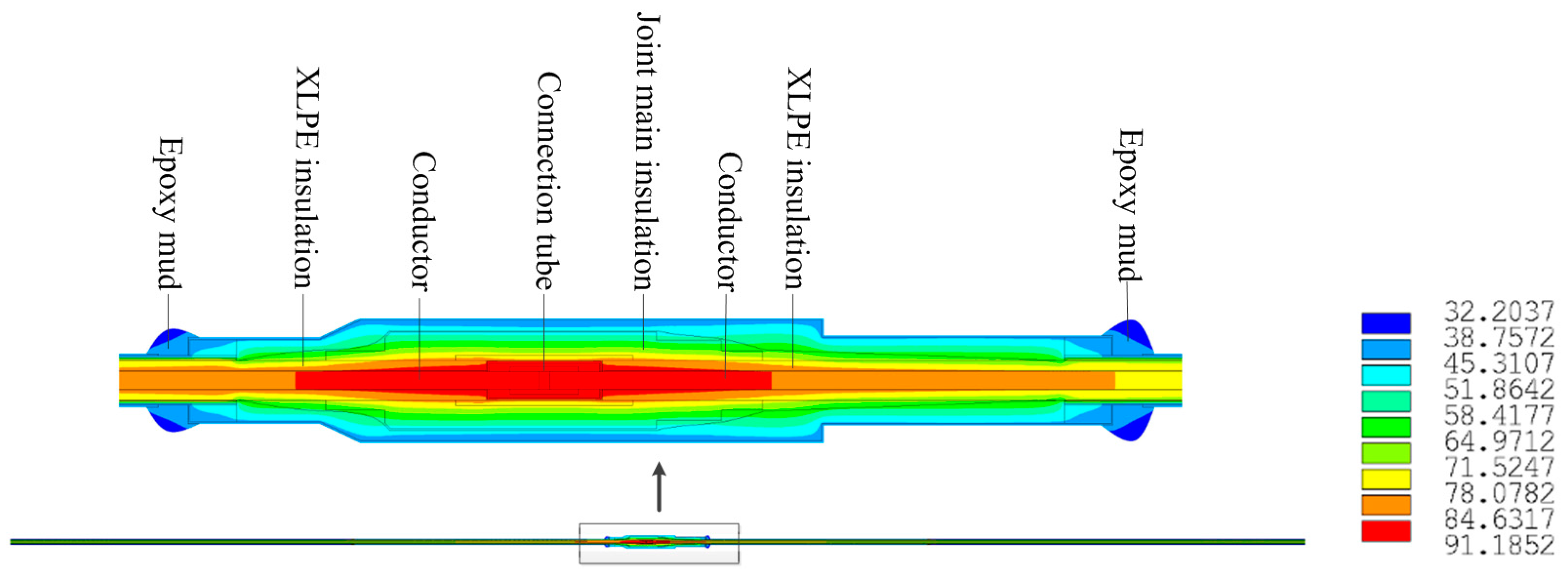
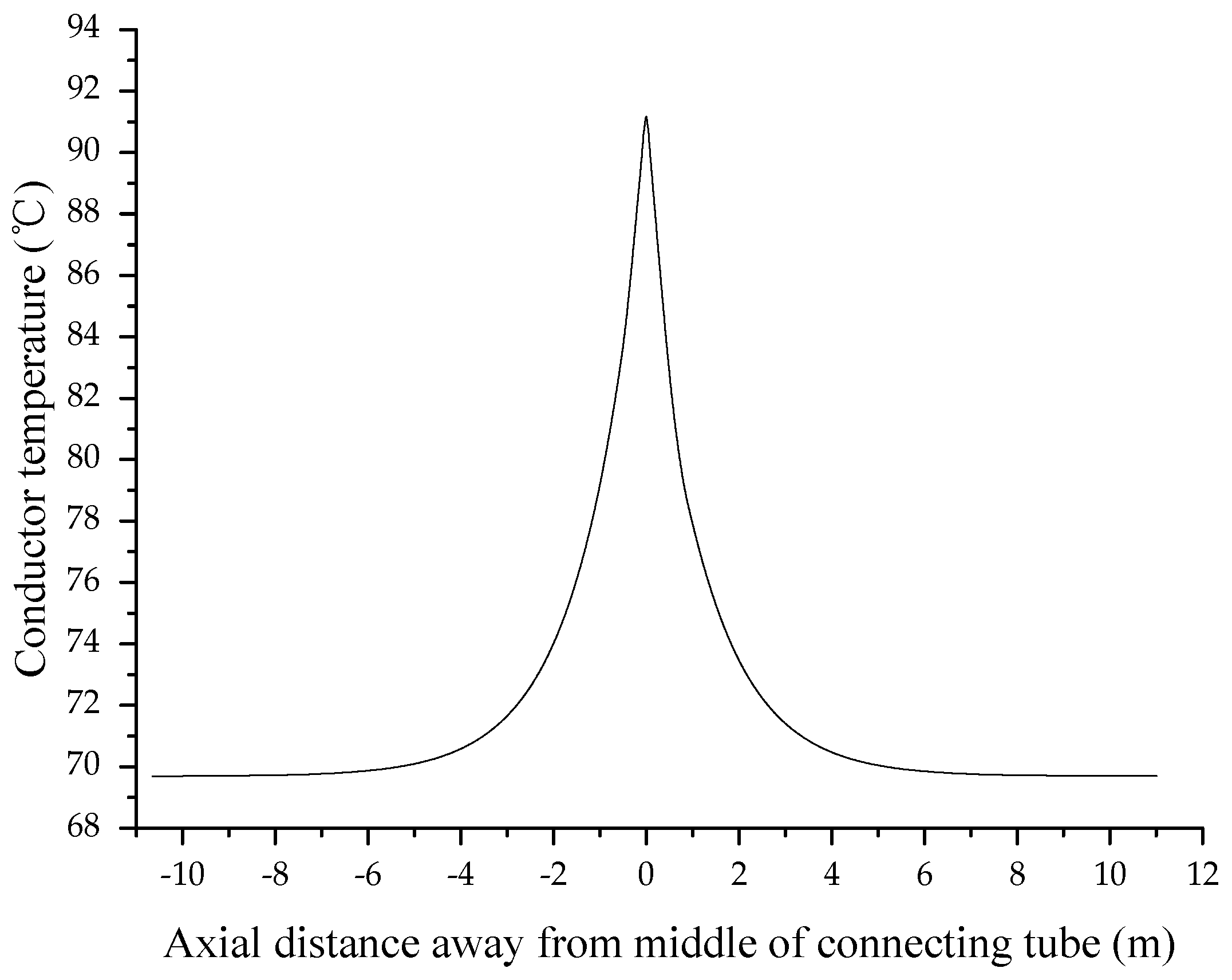
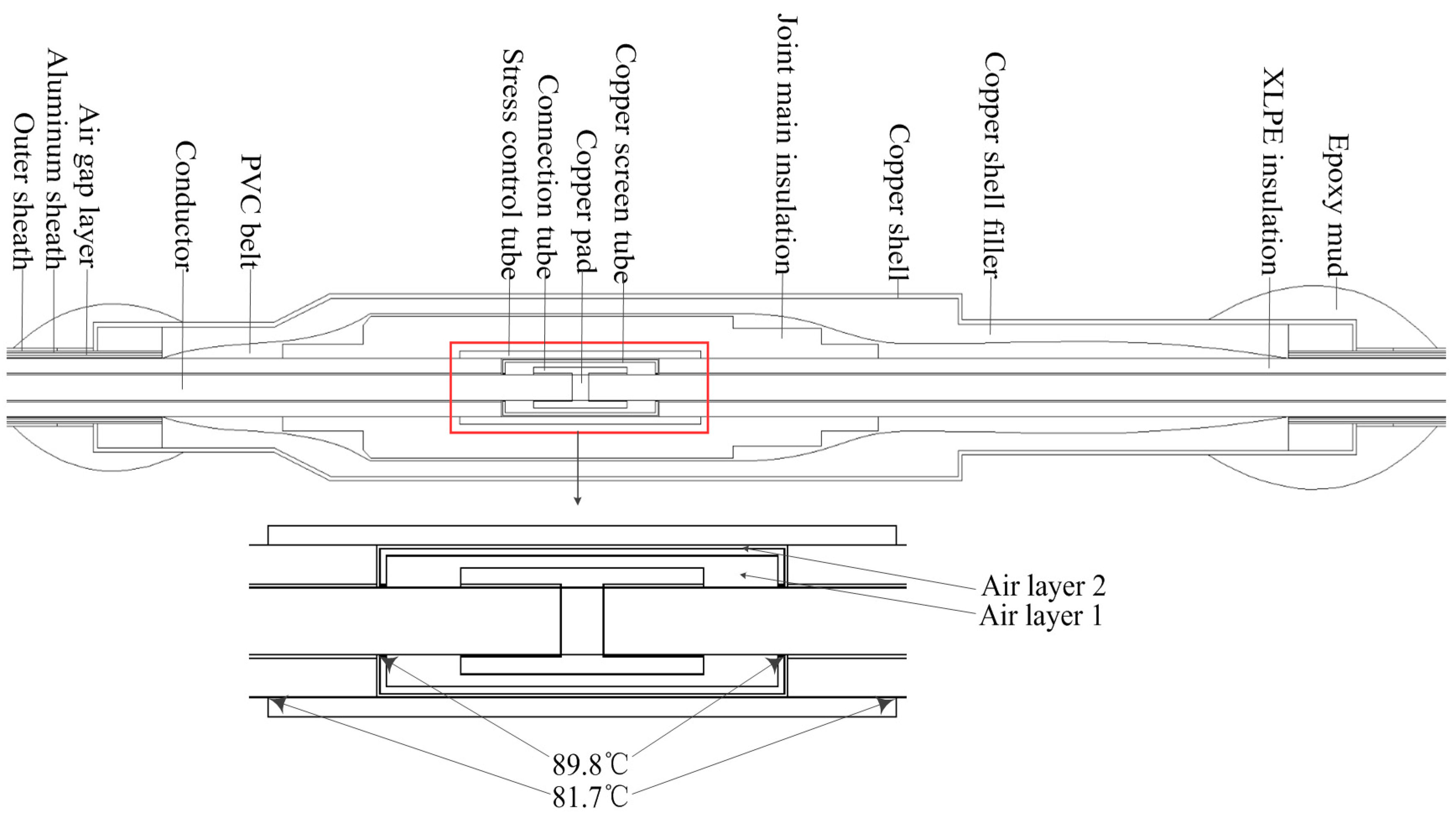

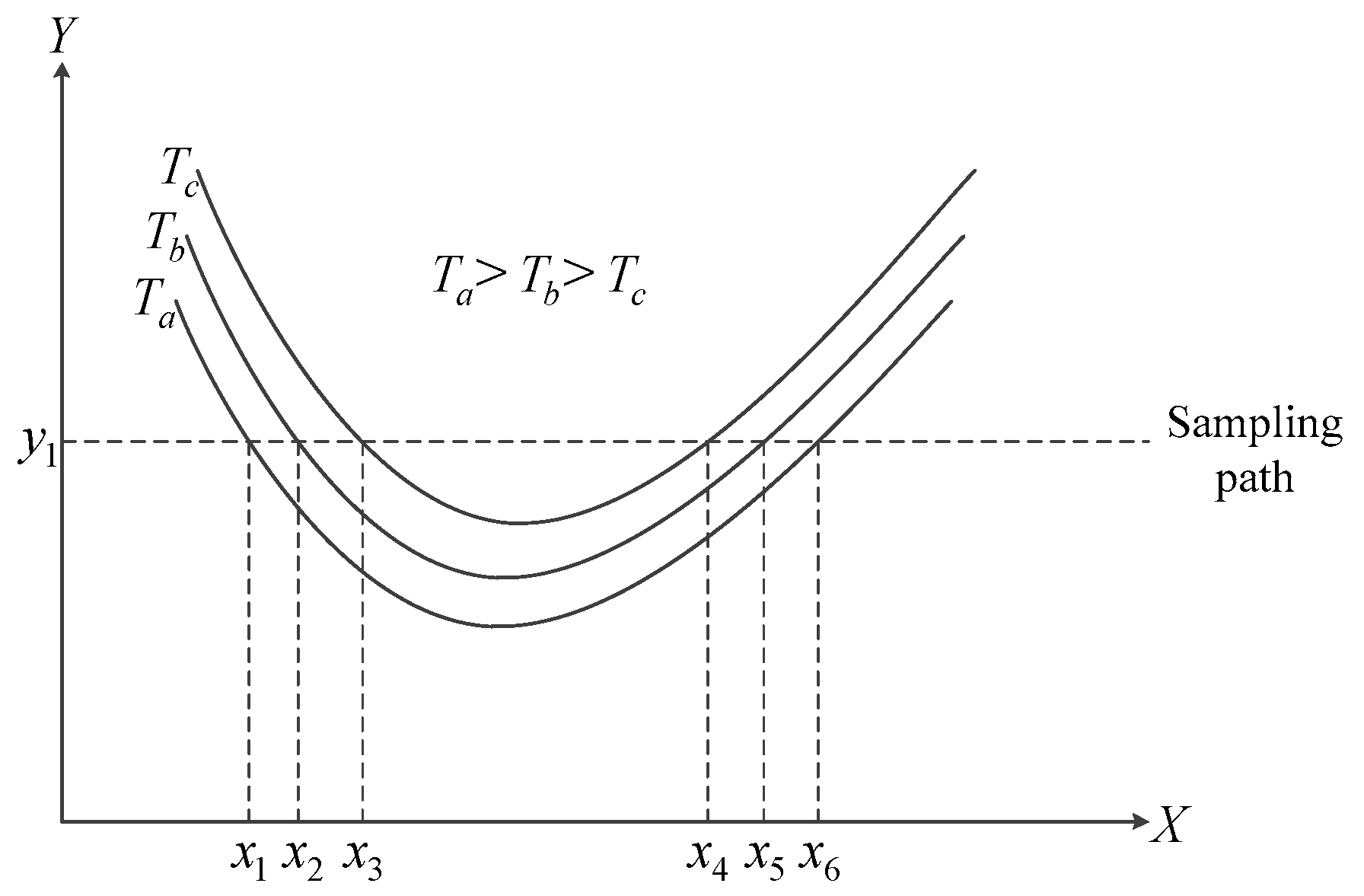

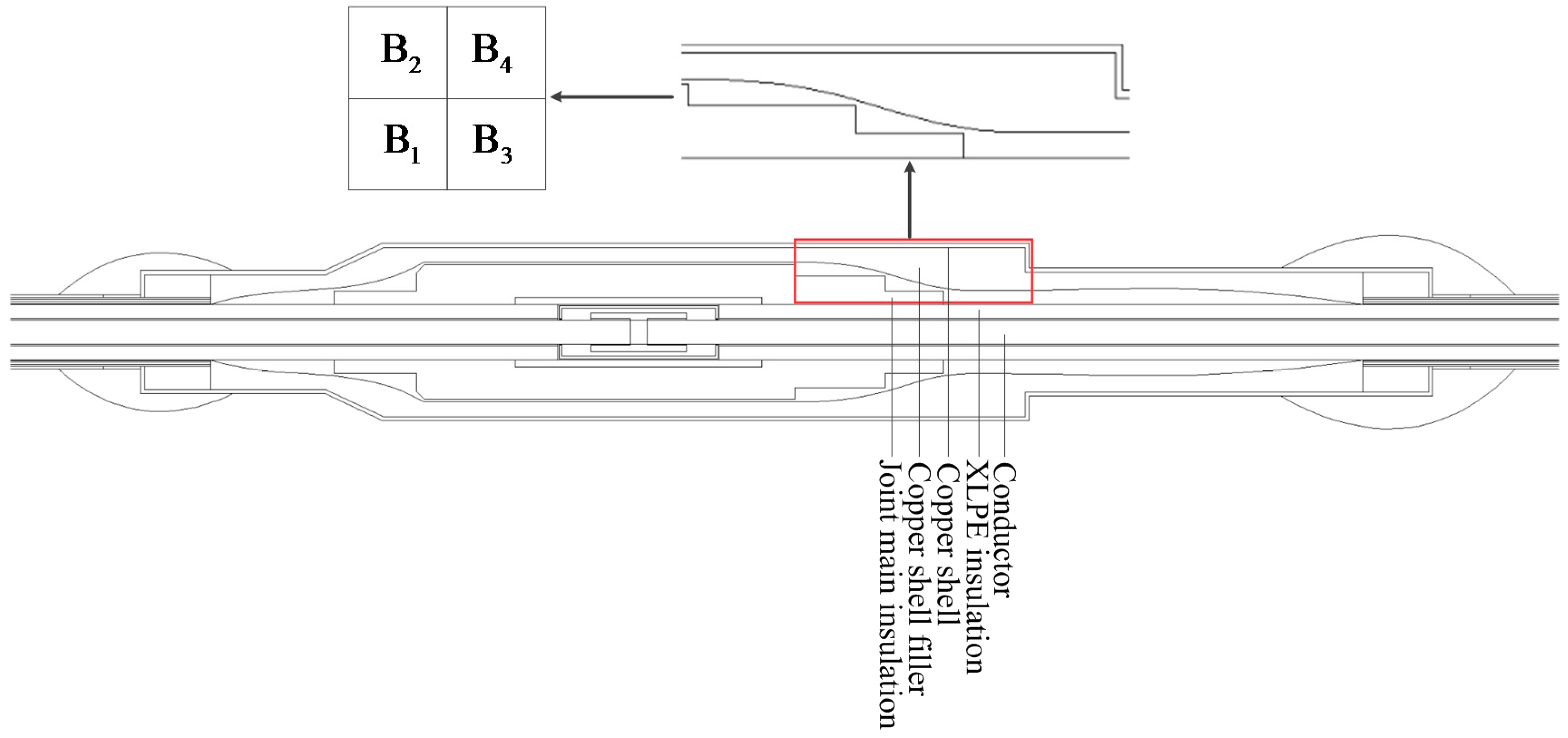

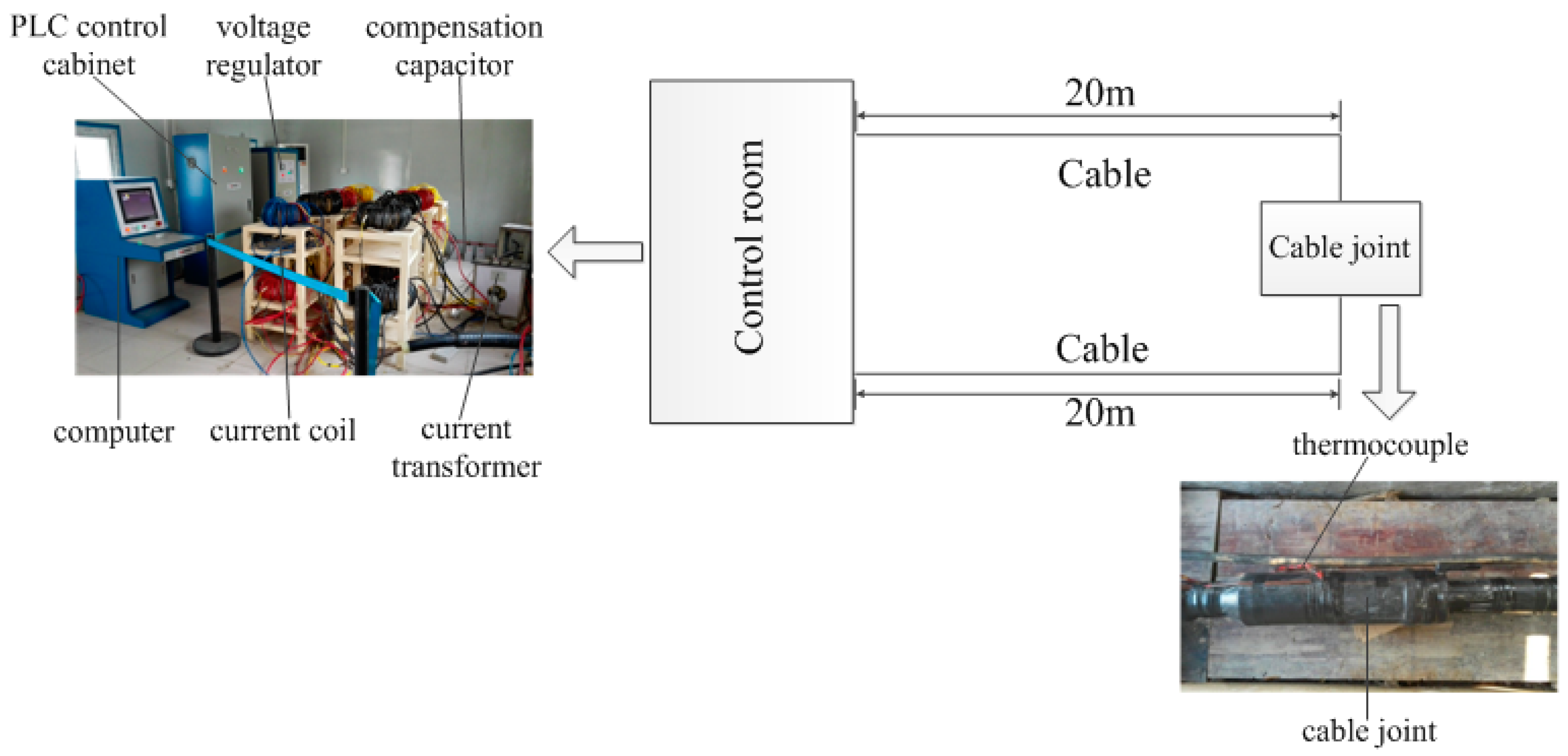
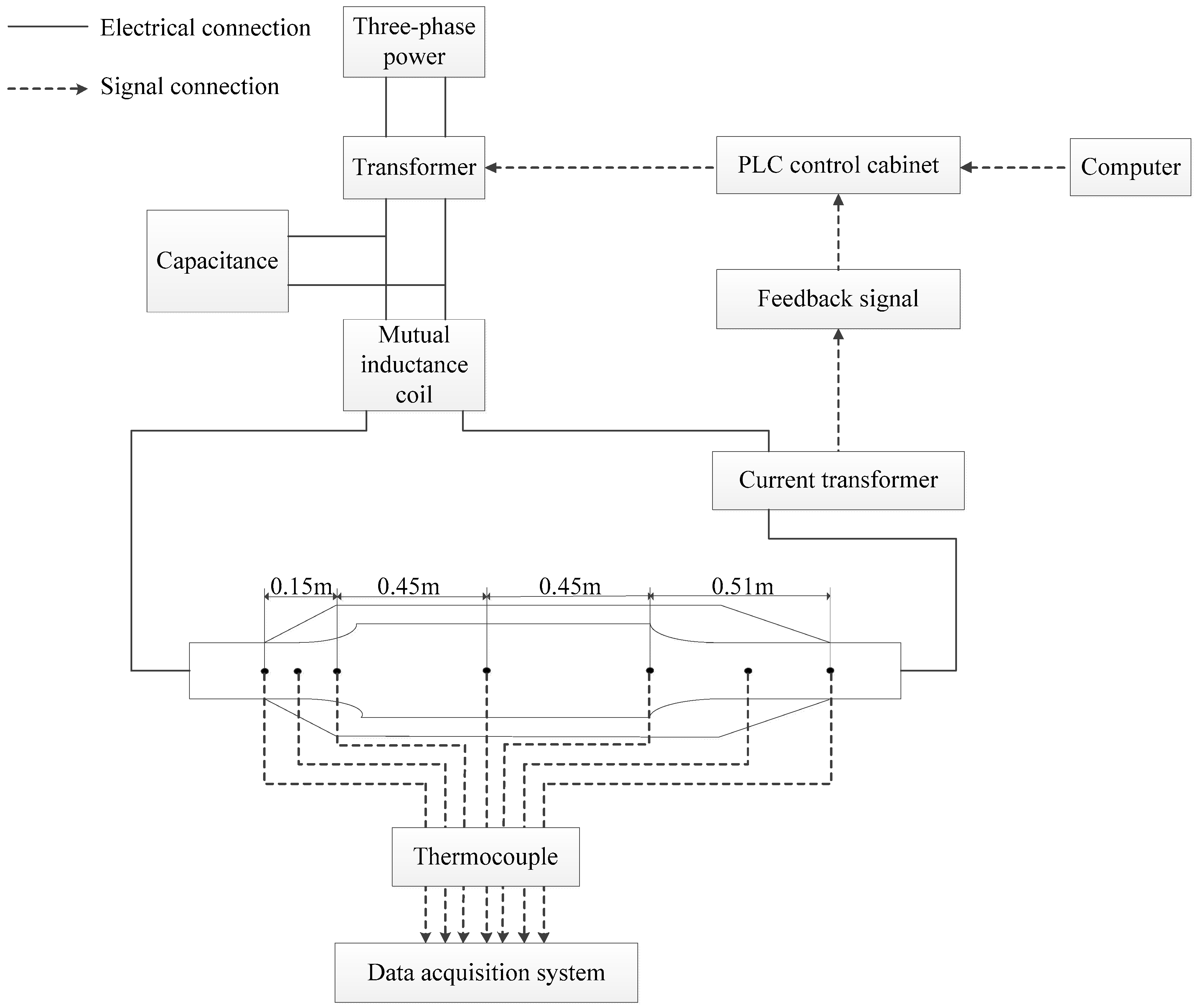
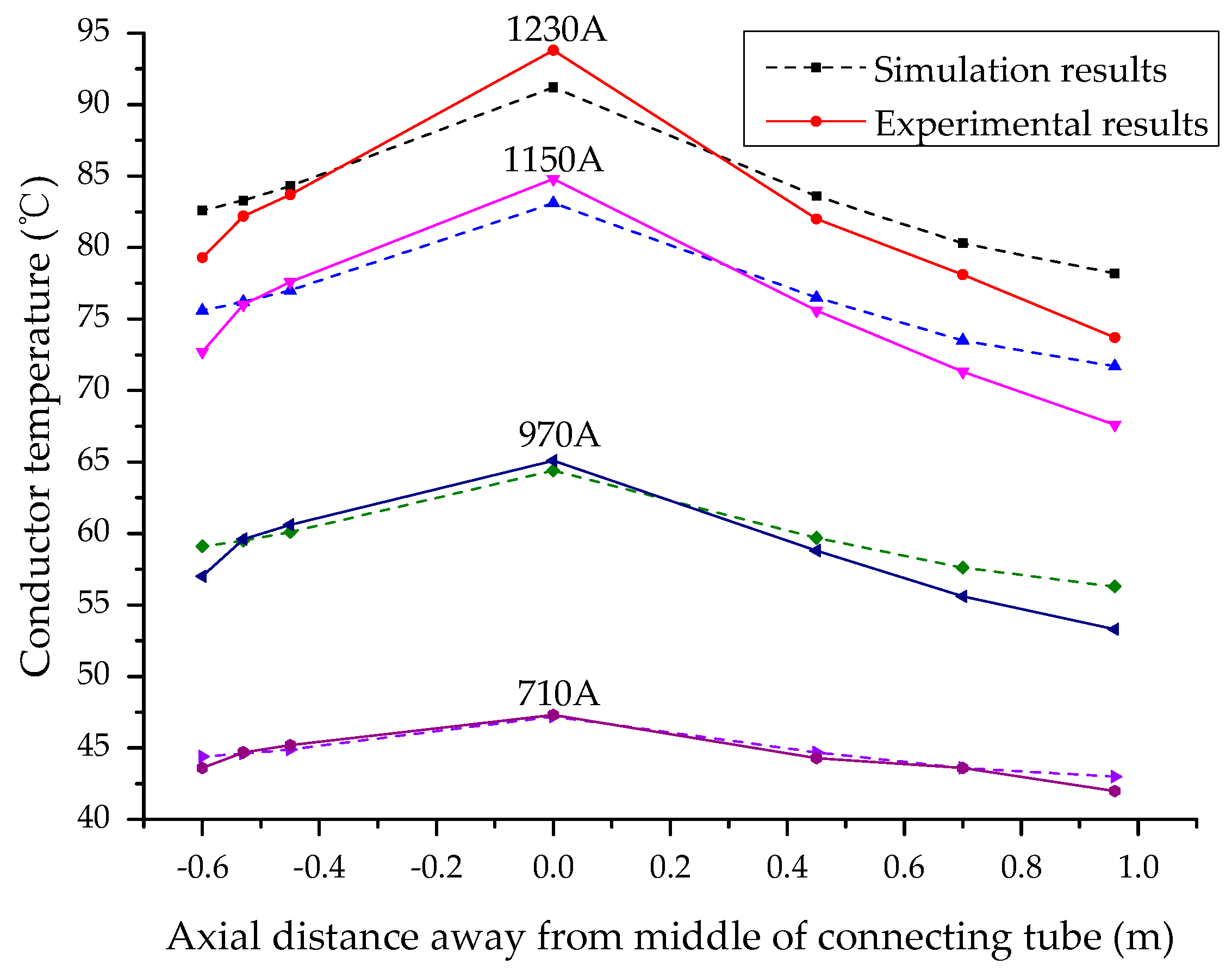
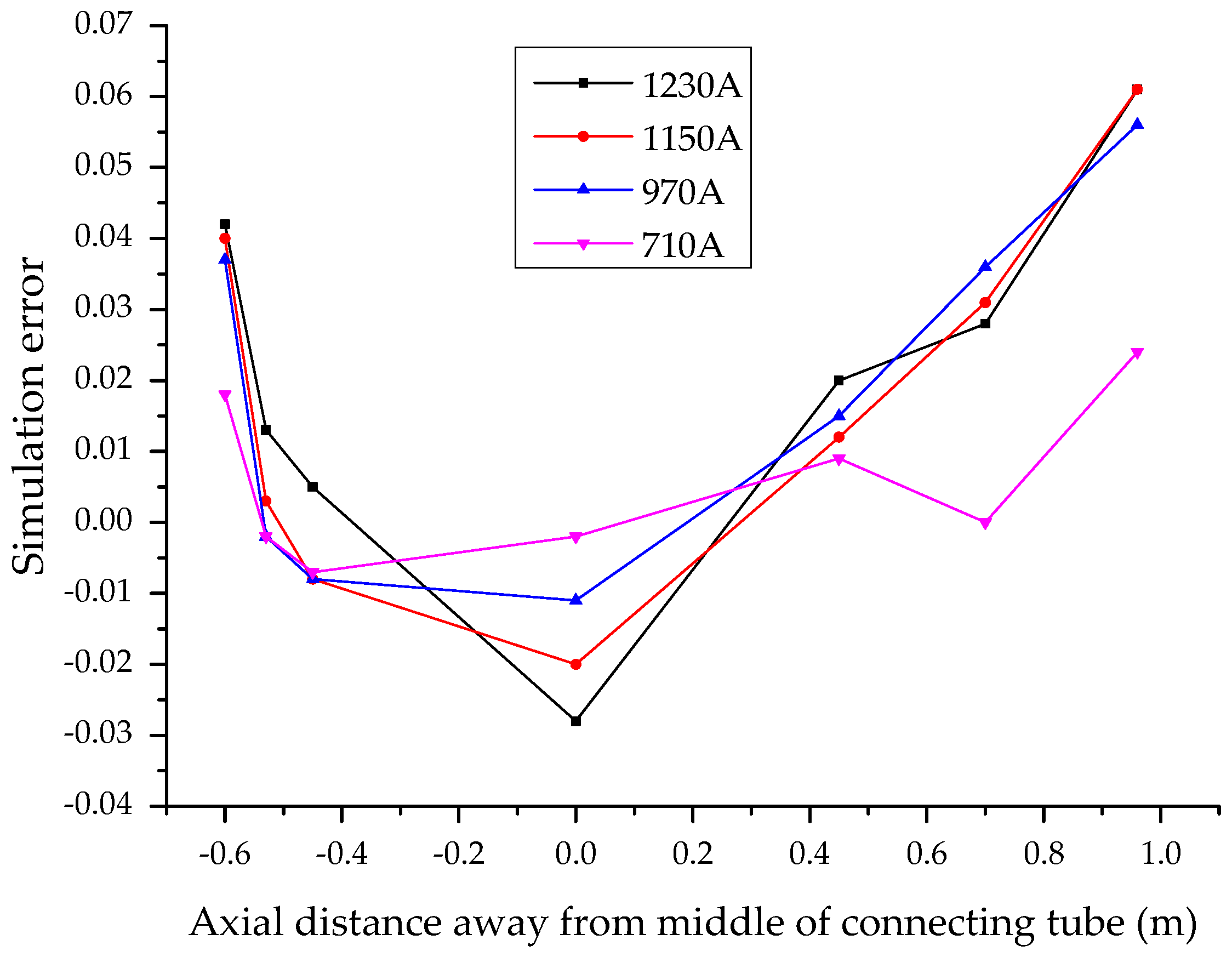
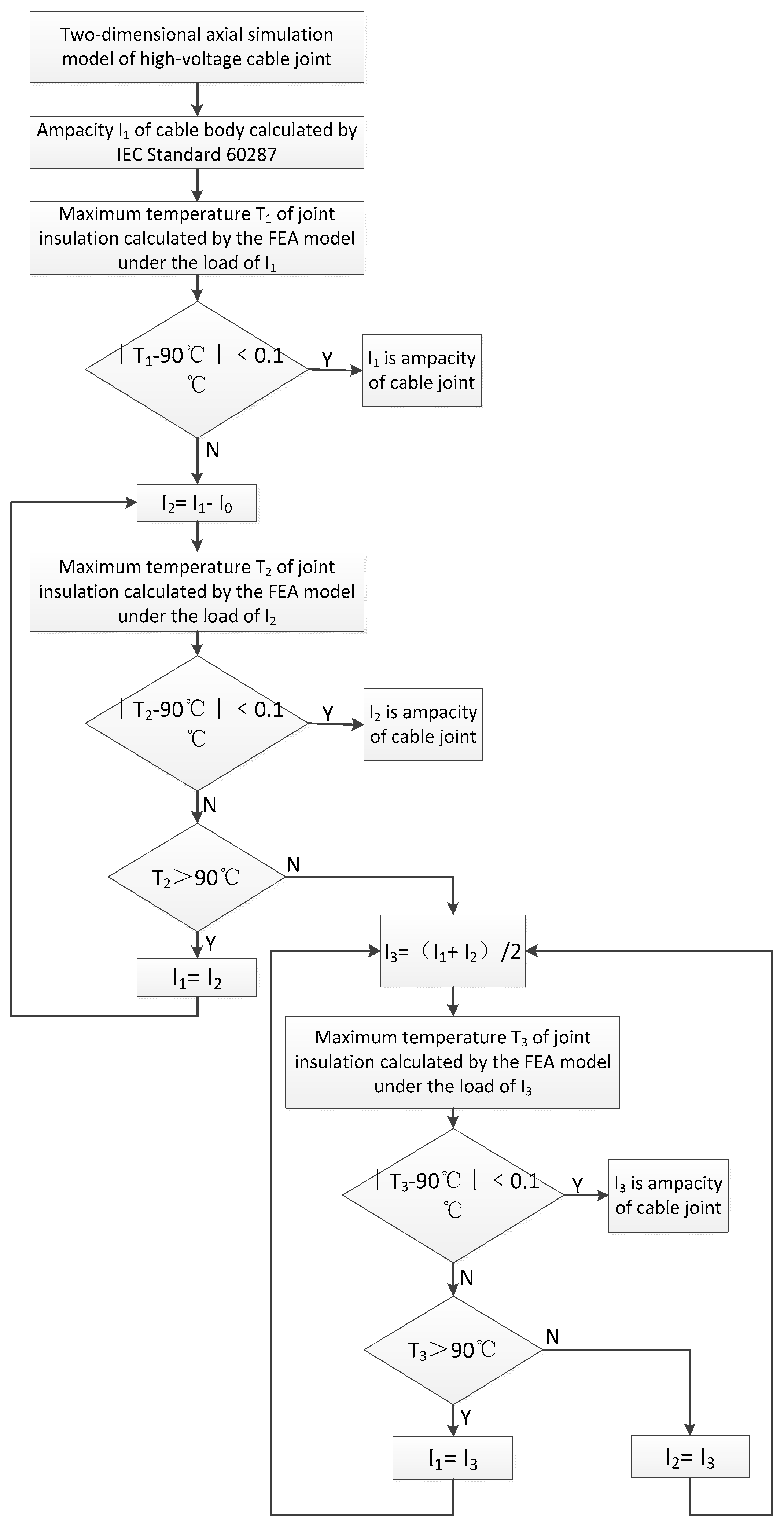
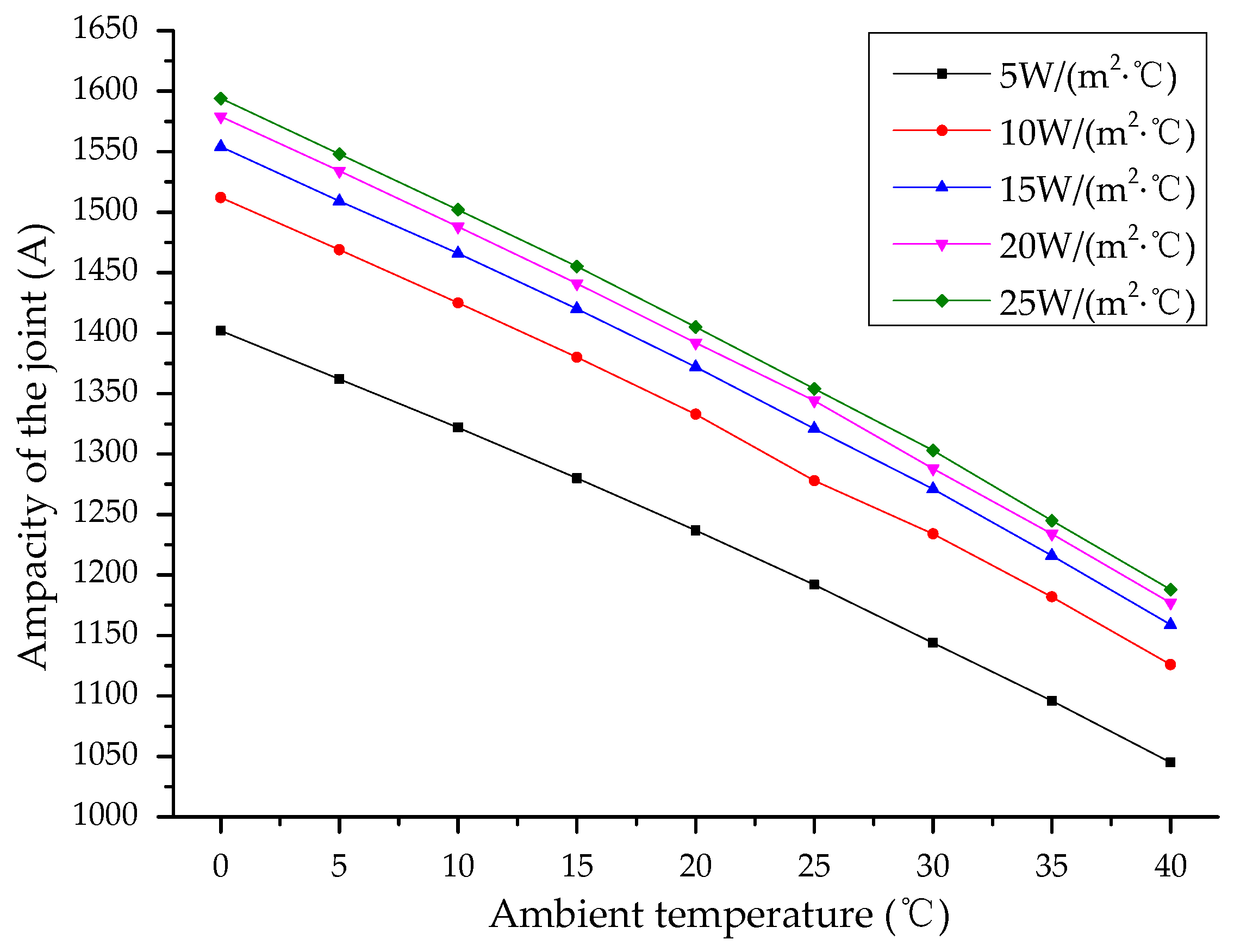
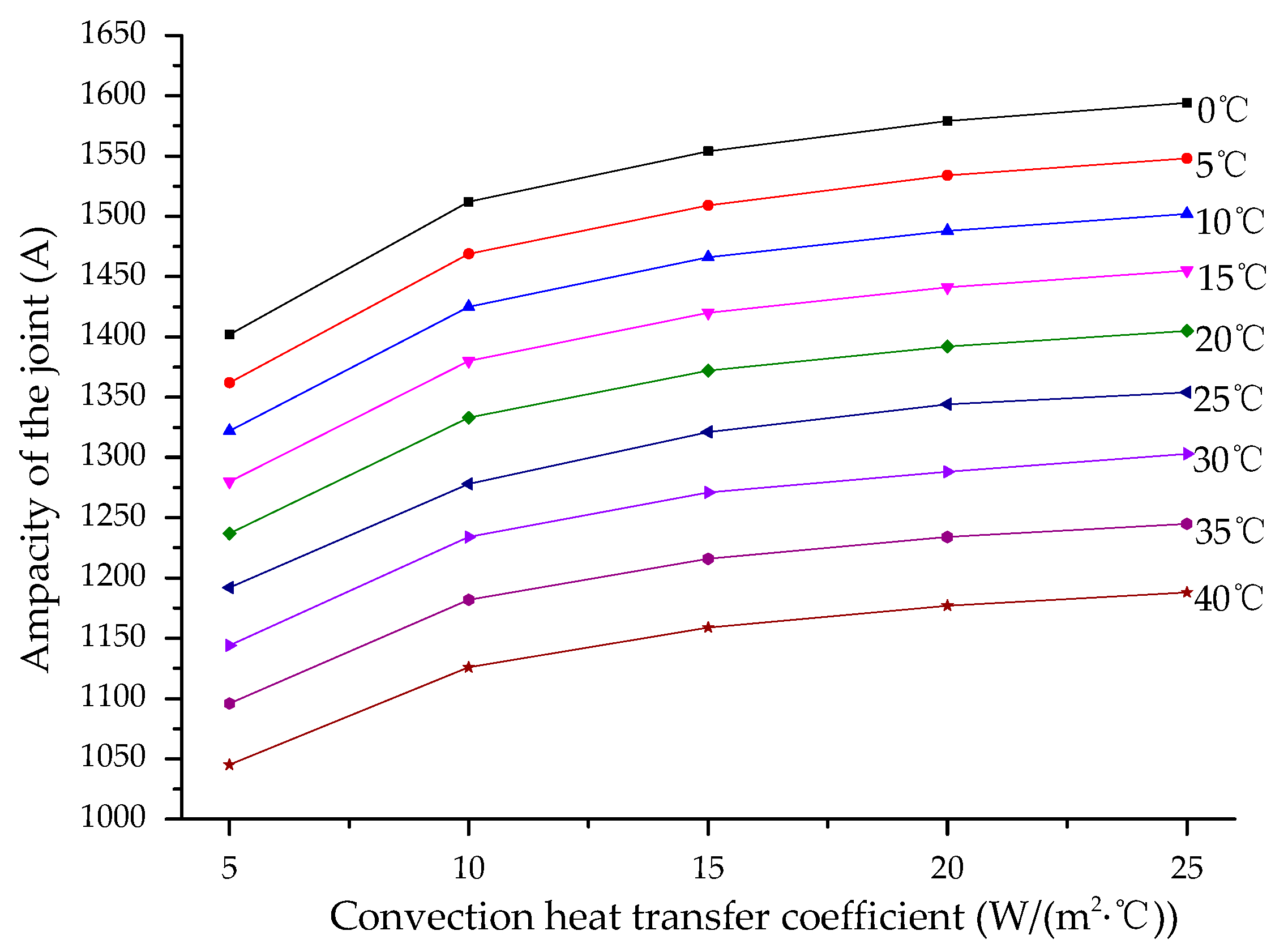
| Component | Material | Thickness (mm) | Thermal Conductivity (W·m−1·K−1) |
|---|---|---|---|
| Conductor | Copper | 15.0 | 401 |
| Connection tube | Copper | 7.3 | 401 |
| Conductor Shield | Polyolefin | 1.5 | 0.38 |
| Insulation Shield | Polyolefin | 1.0 | 0.38 |
| XLPE Insulation | Cross-linked Polyethylene | 17.0 | 0.4 |
| Joint Main Insulation | Ethylene Propylene Rubber | / | 0.25 |
| PVC Belt | Polyvinyl Chloride | 2.0 | 0.1667 |
| Copper Shell Filler | Epoxy Resin Sealant | / | 0.5 |
| Copper Shell | Copper | 3.1 | 401 |
| Air Gap Layer | Air | 3.0 | 0.023 |
| Aluminum Sheath | Aluminum | 2.5 | 237 |
| Outer Sheath | Medium Density Polyethylene | 3.0 | 0.32 |
| The Structure | Inner Diameter Temperature (°C) | Outer Diameter Temperature (°C) | Temperature Difference (°C) |
|---|---|---|---|
| Conductor | 91.1 | 91.0 | 0.1 |
| Air layer 1 | 91.0 | 89.8 | 1.2 |
| Copper screen tube | 89.8 | 89.8 | 0 |
| Air layer 2 | 89.8 | 80.1 | 9.7 |
| Stress control tube | 80.1 | 74.4 | 5.7 |
| Main Insulation | 74.4 | 47.4 | 27.0 |
| Copper Shell Filler | 47.4 | 41.3 | 6.1 |
| Copper Shell | 41.3 | 41.2 | 0.1 |
© 2017 by the authors. Licensee MDPI, Basel, Switzerland. This article is an open access article distributed under the terms and conditions of the Creative Commons Attribution (CC BY) license (http://creativecommons.org/licenses/by/4.0/).
Share and Cite
Wang, P.; Liu, G.; Ma, H.; Liu, Y.; Xu, T. Investigation of the Ampacity of a Prefabricated Straight-Through Joint of High Voltage Cable. Energies 2017, 10, 2050. https://doi.org/10.3390/en10122050
Wang P, Liu G, Ma H, Liu Y, Xu T. Investigation of the Ampacity of a Prefabricated Straight-Through Joint of High Voltage Cable. Energies. 2017; 10(12):2050. https://doi.org/10.3390/en10122050
Chicago/Turabian StyleWang, Pengyu, Gang Liu, Hui Ma, Yigang Liu, and Tao Xu. 2017. "Investigation of the Ampacity of a Prefabricated Straight-Through Joint of High Voltage Cable" Energies 10, no. 12: 2050. https://doi.org/10.3390/en10122050
APA StyleWang, P., Liu, G., Ma, H., Liu, Y., & Xu, T. (2017). Investigation of the Ampacity of a Prefabricated Straight-Through Joint of High Voltage Cable. Energies, 10(12), 2050. https://doi.org/10.3390/en10122050






